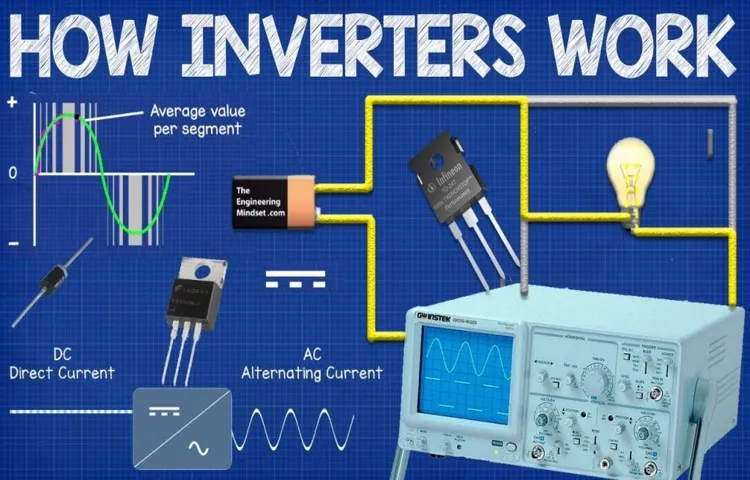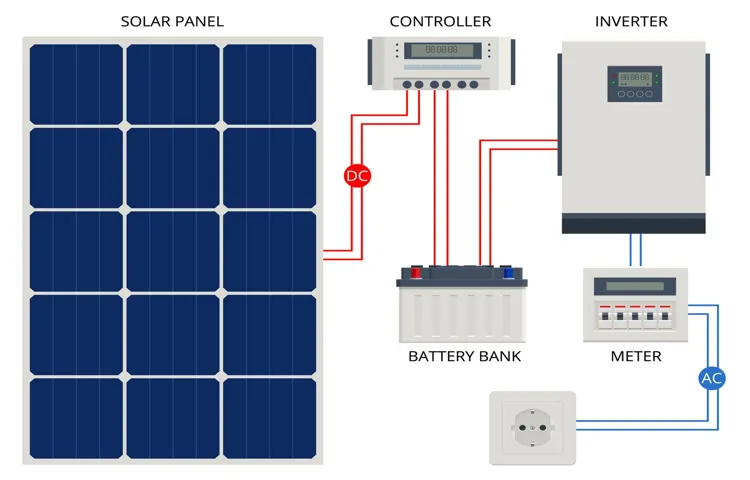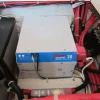Welcome to the world of solar power inverters! If you’re interested in renewable energy and exploring ways to harness the power of the sun, then you’ve come to the right place. Solar power inverters play a crucial role in converting the direct current (DC) energy generated by solar panels into usable alternating current (AC) electricity for your home or business. Think of a solar power inverter as the “translator” between your solar panels and your electrical system.
Just like a translator helps you understand and communicate with someone who speaks a different language, a solar power inverter allows your solar panels and electrical system to understand and work together seamlessly. But why is this translation necessary? Well, solar panels generate DC electricity, which is the same type of electricity that your car battery or portable devices use. However, most of the appliances and devices in your home or business run on AC electricity.
This is where the solar power inverter comes in, efficiently converting the DC electricity from your solar panels into AC electricity that can power your lights, appliances, and more. Solar power inverters come in different types and sizes, depending on your specific needs. From string inverters that are connected to multiple solar panels, to microinverters that are attached to individual panels, there are options to fit every situation.
Some inverters even have built-in technology that allows you to monitor and control your solar system remotely, giving you greater flexibility and control over your energy usage. Not only does solar power provide a clean and sustainable energy source, but it can also save you money on your utility bills in the long run. By utilizing the power of the sun, you can reduce your dependence on traditional energy sources and contribute to a greener future.
So, whether you’re considering installing a solar power system for your home or business, or simply curious about how it all works, this blog will guide you through the exciting world of solar power inverters. Get ready to join the solar revolution and unlock the potential of renewable energy!
Table of Contents
What is a Solar Power Inverter
So, you’ve got solar panels on your roof and you’re wondering how in the world they turn sunlight into electricity. Well, let me introduce you to the unsung hero of the solar power system – the inverter. Think of the inverter as the translator between your solar panels and your home’s electrical system.
Its job is to convert the direct current (DC) electricity produced by the panels into the alternating current (AC) electricity that powers your lights, appliances, and gadgets. It’s like taking a foreign language and translating it into something you can understand. And just like a translator, the inverter has some pretty cool features.
It monitors the electricity flow, ensuring that the solar panels are producing at their maximum capacity and adjusting the voltage to match the needs of your home. So, the next time you turn on a light powered by your solar panels, remember to thank the inverter for its hard work!
Purpose of a Solar Power Inverter
solar power inverter, purpose of a solar power inverter, what is a solar power inverter

Types of Solar Power Inverters
solar power inverters
Working Principles of Solar Power Inverters
Have you ever wondered how solar power inverters work? Well, let’s break it down for you. A solar power inverter is a crucial component of a solar power system. Its main task is to convert the direct current (DC) produced by the solar panels into alternating current (AC) that can be used to power our homes and other electrical appliances.
It essentially acts as the bridge between the solar panels and the electrical grid. It’s like a translator, taking the language of the sun and translating it into a language that our appliances can understand. This is important because most of our electrical appliances, such as lights, refrigerators, and TVs, operate on AC power.
The solar power inverter adjusts the voltage, ensures that the power quality is stable, and synchronizes the AC power with the grid. In other words, it ensures that the power produced by your solar panels is compatible with the electricity grid and can be used to power your home. So, the next time you see a solar power inverter, remember that it’s the key to unlocking the sun’s energy and powering your home.
Input Stage of a Solar Power Inverter
solar power inverter, working principles, input stage Are you wondering how a solar power inverter actually works? Well, let me break it down for you! One of the key components of a solar power inverter is the input stage. This stage is responsible for converting the direct current (DC) generated by the solar panels into alternating current (AC) that can be used to power our homes and businesses. But how does it actually do this? The input stage of a solar power inverter consists of several components working together.
First, the DC power from the solar panels is fed into a set of switches called power transistors. These transistors act as gates, controlling the flow of electricity and converting it into a series of pulses. These pulses are then fed into a transformer.
The transformer is where the magic happens. It takes the pulses from the transistors and converts them into a higher voltage alternating current. This transformation is essential for two reasons.
Firstly, it allows the solar power inverter to match the voltage of the AC power grid, ensuring a seamless integration. And secondly, it allows the inverter to increase the power output, making it more efficient. But how does the input stage actually control the switching of the transistors? Well, it does this by using a technique called Pulse Width Modulation (PWM).
This technique involves modulating the width of the pulses, which in turn controls the amount of power being sent to the transformer. By adjusting the width of the pulses, the inverter can regulate the voltage and frequency of the AC output. Overall, the input stage of a solar power inverter plays a crucial role in converting the DC power from solar panels into the AC power that we use in our daily lives.
By utilizing transistors, transformers, and PWM techniques, it ensures a smooth and efficient conversion process. So next time you see a solar panel, remember the hard work happening behind the scenes in the input stage of a solar power inverter!
DC-DC Conversion Stage
solar power inverters
DC-AC Conversion Stage
Solar power inverters play a vital role in converting the direct current (DC) generated by solar panels into alternating current (AC) that can be used to power our homes and businesses. The DC-AC conversion stage is where the magic happens, and it’s fascinating to understand the working principles behind it. Essentially, the solar power inverter takes the DC electricity produced by the solar panels and passes it through a series of electronic components and circuits.
These components, such as transistors and capacitors, manipulate the DC electricity to create a waveform that mimics the characteristics of AC electricity. This process is essential because most of our electrical devices and appliances run on AC power. By converting the DC electricity into AC electricity, the solar power inverter enables us to use the energy generated by the sun to power our homes and enjoy the perks of modern living.
It’s like having the ability to transform the raw power of the sun into a form that can be easily utilized by our everyday electrical devices. With solar power inverters, we can harness the renewable energy from the sun and reduce our reliance on traditional energy sources.
Important Considerations for Solar Power Inverters
So, you’ve decided to go solar and harness the power of the sun to generate clean energy for your home. But how does a solar power inverter work? Well, think of it as the brain of your solar power system. Its main job is to convert the direct current (DC) electricity produced by your solar panels into alternating current (AC) electricity that can be used to power your appliances and electronics.
Just like how a translator helps you understand a different language, a solar power inverter helps your solar energy speak the language of the power grid. It takes the DC energy generated by your solar panels and transforms it into the AC energy that aligns with the electricity used in your home. This way, you can power your lights, charge your devices, and run your appliances seamlessly with the solar energy you’ve generated.
It’s pretty amazing how a small device can make such a big difference in your energy consumption!
Efficiency
Solar power inverters are an essential component of any solar energy system. These devices convert the direct current (DC) generated by solar panels into alternating current (AC) that can be used to power electrical appliances in homes and businesses. When choosing a solar power inverter, one important consideration is its efficiency.
Efficiency refers to the amount of energy that is converted from DC to AC without any loss. A higher efficiency rating means that more of the solar energy produced is being utilized effectively. This not only maximizes the amount of electricity generated but also reduces electricity costs.
Additionally, efficient solar power inverters generate less heat, which increases their lifespan and reduces the need for maintenance and repairs. Overall, choosing an efficient solar power inverter is crucial for optimizing the performance and longevity of a solar energy system.
Maximum Power Point Tracking (MPPT)
solar power inverters, maximum power point tracking, MPPT, important considerations. Are you considering installing a solar power system for your home or business? If so, it’s important to familiarize yourself with maximum power point tracking (MPPT) and the important considerations for solar power inverters. MPPT is a technology used in solar power inverters that allows for maximum efficiency and energy production.
It works by continuously adjusting the output voltage and current of the solar panels to ensure they are operating at their maximum power point. This means that even in varying weather conditions or shading, the solar panels are able to generate the maximum amount of power possible. When choosing a solar power inverter, it’s crucial to consider MPPT capabilities.
A high-quality inverter with MPPT will ensure that you get the most out of your solar panels and maximize the energy production of your system. So, when you’re shopping for a solar power inverter, be sure to ask about MPPT and choose a model that has this important feature. It will make a significant difference in the performance and efficiency of your solar power system.
Conclusion
In conclusion, a solar power inverter is like the electrical superhero of the solar energy world. It takes the direct current generated by the sun and converts it into the alternate current that powers our homes and devices. It’s like taking a sunny high-five from the sun and turning it into a dynamic electrical dance party.
With its magical wave-shaping abilities, it ensures that every bit of solar energy is used efficiently and effectively. Just imagine the inverter as the smooth-talking translator between the sun and your appliances, making sure they all speak the same electrical language. So, the next time you see a solar power inverter, give it a nod of respect for its incredible ability to transform sunlight into the electricity that powers our lives.
Because when it comes to harnessing the power of the sun, the inverter is truly the master of conversion, the conductor of energy, and the conductor of a clean, green future.
FAQs
How does a solar power inverter work and what is its role in a solar power system?
A solar power inverter converts the direct current (DC) produced by solar panels into alternating current (AC) that can be used to power electrical appliances. It is a critical component in a solar power system as it ensures that the electricity generated by the solar panels can be used effectively in homes or buildings.
What are the main components of a solar power inverter?
A solar power inverter typically consists of power electronics, a transformer, and control circuits. The power electronics convert the DC electricity into AC electricity, the transformer adjusts the voltage to the appropriate level, and the control circuits monitor and regulate the overall operation of the inverter.
How efficient are solar power inverters in converting DC to AC electricity?
Solar power inverters have a high efficiency rate, typically ranging from 95% to 99%. This means that they convert a large majority of the DC electricity generated by the solar panels into usable AC electricity without significant energy losses.
Can solar power inverters work without sunlight?
Solar power inverters require sunlight or any other source of solar radiation to generate electricity from solar panels. In the absence of sunlight, solar power inverters cannot produce electricity.
What types of solar power inverters are available in the market?
There are several types of solar power inverters available, including string inverters, microinverters, and power optimizers. String inverters are commonly used in residential and commercial installations, while microinverters and power optimizers are often used in systems with shaded or complex roof configurations.
Are solar power inverters prone to failure?
Like any electronic device, solar power inverters can fail or experience issues over time. However, with proper maintenance and regular monitoring, the likelihood of inverter failure can be minimized. Most inverters come with warranties to cover potential failures during their operational lifespan.
Can a solar power inverter be used to store excess electricity?
No, a solar power inverter is not designed to store excess electricity. Its primary function is to convert DC electricity into AC electricity for immediate use or to feed it into the electrical grid. Energy storage systems, such as batteries, are used to store excess electricity for later use when solar production is low.



